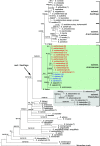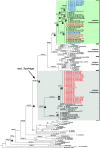Contrasting evolutionary origins of two mountain endemics: Saxifraga wahlenbergii (Western Carpathians) and S. styriaca (Eastern Alps)
- PMID: 30634910
- PMCID: PMC6329101
- DOI: 10.1186/s12862-019-1355-x
Contrasting evolutionary origins of two mountain endemics: Saxifraga wahlenbergii (Western Carpathians) and S. styriaca (Eastern Alps)
Abstract
Background: The Carpathians and the Alps are the largest mountain ranges of the European Alpine System and important centres of endemism. Among the distinctive endemic species of this area is Saxifraga wahlenbergii, a Western Carpathians member of the speciose genus Saxifraga. It was frequently considered a taxonomically isolated Tertiary palaeopolyploid and palaeoendemic, for which the closest relatives could not yet be traced. A recently described narrow endemic of the Eastern Alps, S. styriaca, was hypothesized to be closely related to S. wahlenbergii based on shared presence of peculiar glandular hairs. To elucidate the origin and phylogenetic relationships of both species we studied nuclear and plastid DNA markers based on multiple accessions and analysed the data in a wide taxonomic context. We applied Sanger sequencing, followed by targeted next-generation sequencing (NGS) for a refined analysis of nrITS variants to detect signatures of ancient hybridization. The ITS data were used to estimate divergence times of different lineages using a relaxed molecular clock.
Results: We demonstrate divergent evolutionary histories for the two mountain endemics. For S. wahlenbergii we revealed a complicated hybrid origin. Its maternal parent belongs to a Western Eurasian lineage of high mountain taxa grouped in subsect. Androsaceae and is most likely the widespread S. androsacea. The putative second parent was most likely S. adscendens, which belongs to the distantly related subsect. Tridactylites. While Sanger sequencing of nrITS only showed S. adscendens-related variants in S. wahlenbergii, our NGS screening revealed presence of sequences from both lineages with clear predominance of the paternal over the maternal lineage.
Conclusions: Saxifraga styriaca was unambiguously assigned to subsect. Androsaceae and is not the sister taxon of S. wahlenbergii. Accordingly, the similarity of the glandular hairs observed in both taxa rests on parallelism and both species do not constitute an example of a close evolutionary link between the floras of the Western Carpathians and Eastern Alps. With the origin of its paternal, S. adscendens-like ITS DNA estimated to ca. 4.7 Ma, S. wahlenbergii is not a relict of the mid-Tertiary climate optimum. Its hybrid origin is much younger and most likely took place in the Pleistocene.
Keywords: Alps; Carpathians; Endemics; European mountains; Hybrid speciation; ITS genomic screening; Molecular clock; NGS; Phylogenetics; Tertiary relict.
Conflict of interest statement
Ethics approval and consent to participate
Not applicable.
Consent for publication
Not applicable.
Competing interests
The authors declare that they have no competing interests.
Publisher’s Note
Springer Nature remains neutral with regard to jurisdictional claims in published maps and institutional affiliations.
Figures








References
-
- Ozenda P. La végétation de la chaîne alpine dans l’espace montagnard européen. Paris: Masson; 1985.
-
- Ronikier M. Biogeography of high-mountain plants in the Carpathians: an emerging phylogeographical perspective. Taxon. 2011;60:373–389.
-
- Mráz P, Ronikier M. Biogeography of the Carpathians: evolutionary and spatial facets of biodiversity. Biol J Linn Soc. 2016;119:528–559.
-
- Mráz P, Barabas D, Lengyelová L, Turis P, Schmotzer A, Janišová M, Ronikier M. Vascular plant endemism in the Western Carpathians: spatial patterns, environmental correlates and taxon traits. Biol J Linn Soc. 2016;119:630–648.
-
- Tzedakis PC, Emerson BC, Hewitt GM. Cryptic or mystic? Glacial tree refugia in northern Europe. Trends Ecol Evol. 2013;28:696–704. - PubMed
Publication types
MeSH terms
Substances
LinkOut - more resources
Full Text Sources

